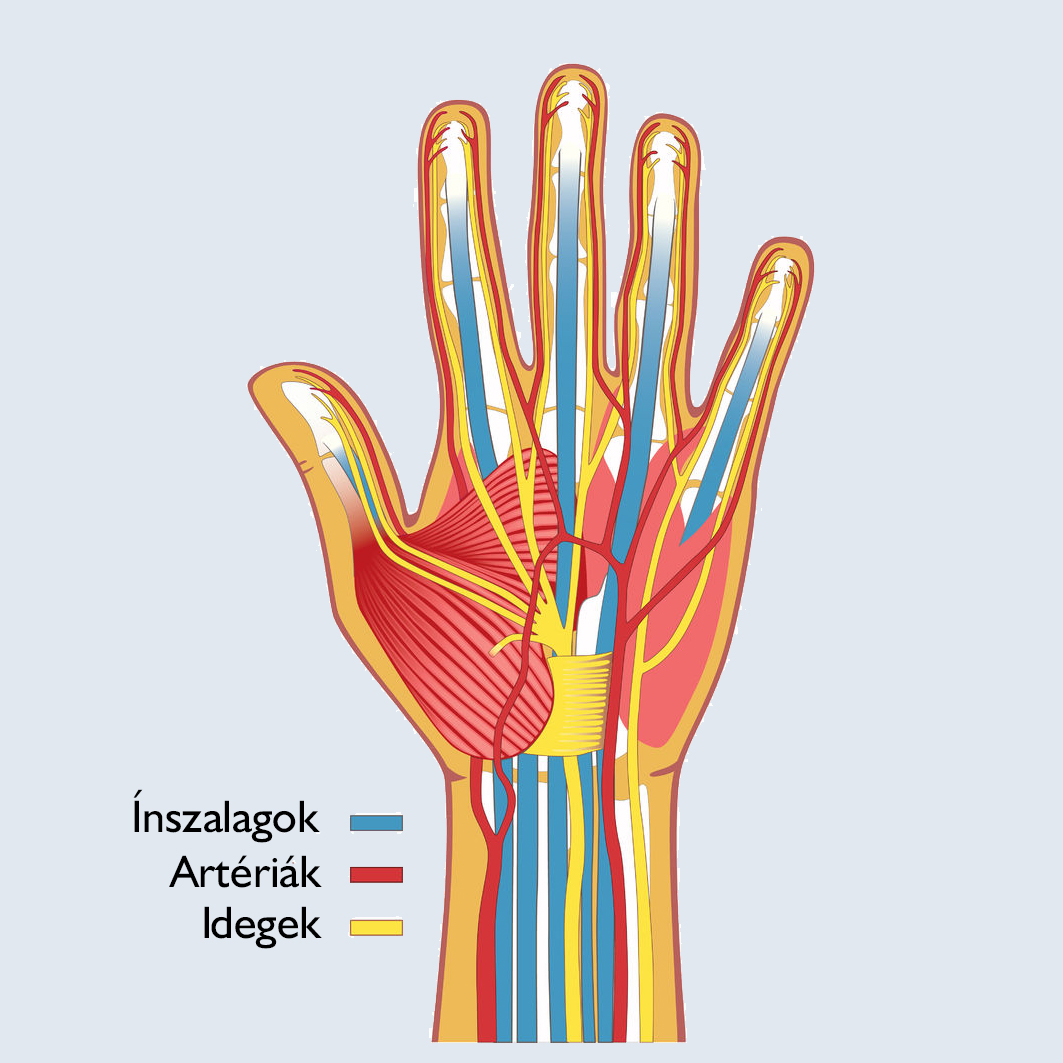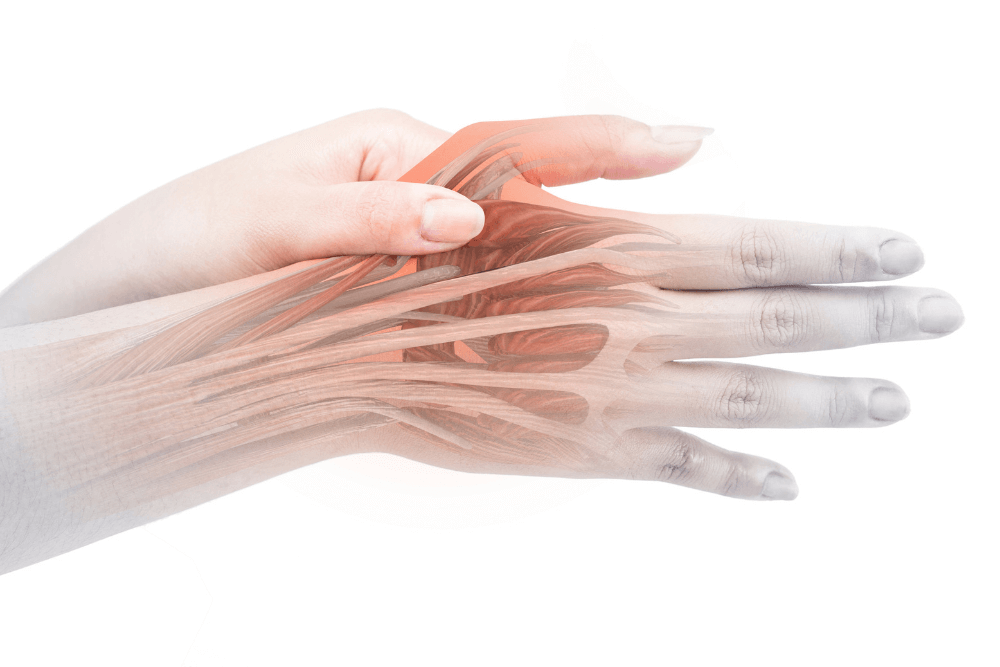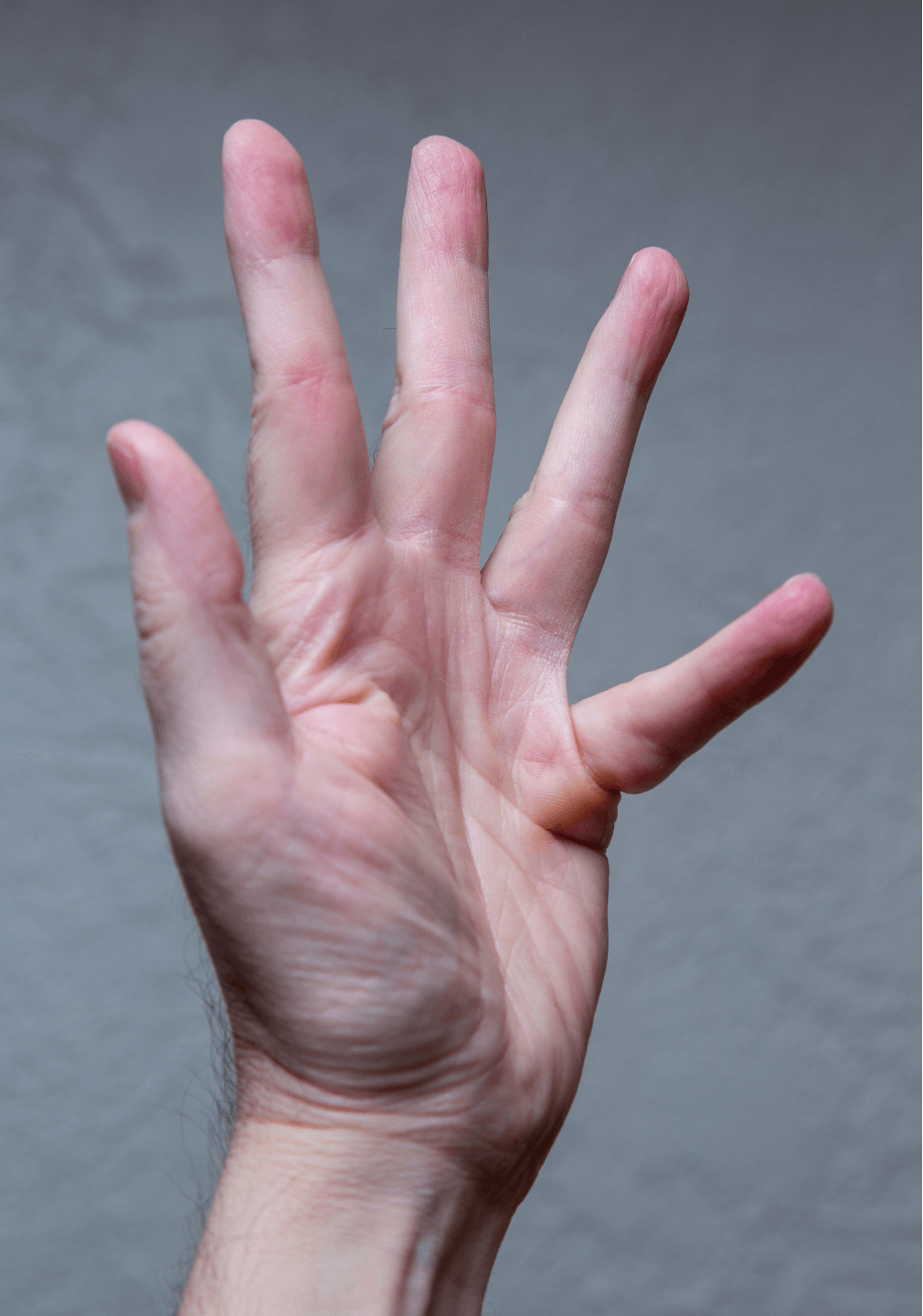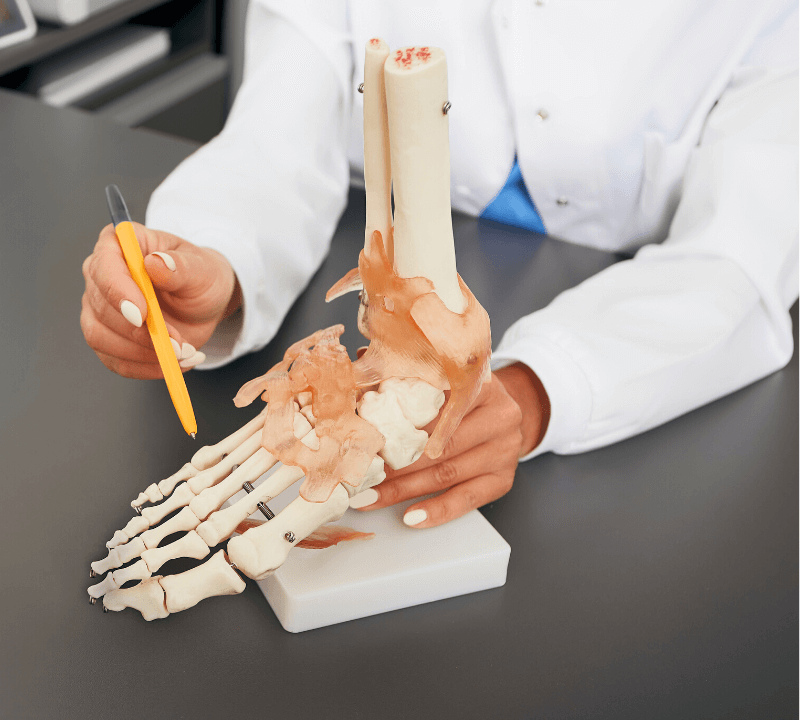Hand and foot surgery
Hand surgery
The task of a hand surgeon is primarily to treat injuries and degenerative lesions of the hand, primarily surgically, and their aftercare, the main purpose of which is to restore and maintain sensory functions and restore fine movements.
In addition, the field of hand surgery also includes developmental disorders of the hand, inflammatory and cancerous lesions.
Restoring the structures of the hand requires special knowledge and extremely fine technique, as the coordinated operation of the hand is performed by complex tendon, nerve and vascular formulas, bone and joint systems, which requires the coordinated operation of nearly 200 fine formulas. To get to know them as accurately as possible, and to develop surgical technologies, hand surgery has become a separate field.
Successful treatment of hand lesions depends to a large extent on the training of the hand surgeon, supposes a thorough knowledge of the anatomy and functional anatomy of the hand, as well as a sound knowledge of the principles of hand surgery.
What types of injuries does hand surgery deal with?
Injuries of the hand are extremely common due to its many functions, accounting for ¼ injuries of the body. Most injuries are due to the grip function of the hand, but injuries during protective operation are similarly common (e.g., in the event of an accident when the hand is reflexively protecting the head or torso).
Hand injuries are often more severe than it would result from the injury alone. This is due to the fact that several formulas can be damaged at the same time, which in the case of improper care can cause coalescences around the tendons and the formation of scars, which can even cause subsequent loss of function. Therefore, in the case of hand injuries, the primary, professional care of the wound is to avoid the functional limitation caused by subsequent scarring.
Hand injuries can be varied, the most common types of injuries are summarized below. These injuries can also be treated by a traumatologist, but due to the complex anatomy of the hand, depending on the severity of the injury, seek the help of a hand surgeon if possible.

Minor hand injuries
Minor hand injuries include abrasions that only affect the upper layers of the skin and require sterile bandage and disinfection to treat them.
Injuries caused by a foreign body are also common, which can be caused by, for example, splinters and plant spikes. In such cases, the foreign body must be removed professionally as soon as possible.
In case of cut wounds, it is sufficient to unite the wound edges in case of smaller injuries that only affect the skin, but in the case of deeper injuries, it is important to treat the structures under the wound (blood vessels, tendons, nerves) to avoid later loss of function.
Bite injuries are also common and have an extremely high risk of infection, so the wound definitely requires professional medical attention. In the case of a hand bite, it is especially important that the care is performed by a hand specialist so that the injured formulas are united as accurately as possible.
Bruising of the hand can also be classified as a minor injury, but it should not be neglected in any way. In all cases, it is recommended to show the injury to a specialist to avoid subsequent tissue damage.
Skin injuries
In the case of skin lesions on the hands, it is important that the healing of the skin injury is accompanied by the least possible scarring. Depending on their size, skin lesions can be treated with sutures or skin replacement procedures.
Tendon injuries
Tendons are connective tissue-rich, resistant units responsible for the stability of joints, which transmit the strength of muscles to the bones. The extensor and flexor tendons on the hands and fingers provide all the movement needed for the hand to function smoothly. Their injury can be open and covered, caused by a sharp object, or by a spontaneous rupture that occurs when the fingers are suddenly abnormally strained. Injury of the tendon is usually easily recognizable, as some activity of the fingers of the hand is missing and deformity (curvature) is usually observed. Torn tendons can be repaired with sutures, but even after the repairing operation, the injured finger can be moved indefinitely.
Vascular injuries
Vascular damage can occur during open puncture, incision, bruising, or under compression. Closed injuries are most often direct injuries, e.g. they occur in connection with bone fractures and sprains. The injury is indirect if e.g. it is an overstretched rupture. Sometimes only one layer of the vessel wall is damaged, but this can already be a source of problem. If there is no palpable pulse, and if the limb is pale and cool, these can be symptoms of vascular injury of the hand. If vascular injury is suspected, care should be given as soon as possible because the risk of blood clots and other complications increases over time.
Electrical and thermic injuries
By thermic injuries, we mean burn and frostbite injuries. In case of burns, first aid, cooling with cold running water is very important. First-degree burns associated with erythema do not require special intervention other than analgesia and bandage. In case of second-degree burns with blisters, it may be necessary to open the blisters. In case of third-degree burns, it is always necessary to remove the damaged tissues.

In case of frostbite injury, warming up the limb is the primary task. When it comes to first-degree frostbite, swelling occur, in second-degree, necrosis of the surface tissues and blistering are observed. In the case of third-degree frostbite, the skin dies to its full thickness, damaging the deeper structures as well. In such cases, the removal of dead parts is necessary.
The electric current causes tissue damage in the epidermis, which often also damages the blood vessels running underneath. The current effect can cause temporary movement and sensory disturbances in the limb. It is advisable to excise dead areas as soon as possible to avoid later infections.
What hand surgery procedures are available at Medicover Hospital?
Wrist and hand ganglion excision
Benign lesion of the wrist, hand and fingers. Usually, an enlargement of the joint capsule or tendon sheath, in which a jelly-like substance grows. It can be removed under local or conduction anaesthesia, as a one-day surgical procedure.
Benign hand soft tissue tumour excision
Benign soft tissue lesions on the hand that do not clearly show signs of malignant cancer. They can be removed under local or conduction anaesthesia, as a one-day surgical procedure. After the surgery, the removed material is sent for histological examination for accurate diagnosis.
Benign hand bone tumour excision
Benign bone lesions on the hand that do not clearly show signs of malignant cancer. They can be removed under conduction anaesthesia or general anaesthesia, as a one-day surgical procedure. The removed bone mass is filled with either material taken from the patient’s own bone or with an artificial bone substitute. After the surgery, the removed material is sent for histological examination for an accurate diagnosis.
Gouty deposit excision
Removal of gouty deposits causing complaints on the hand under local or conduction anaesthesia as a one-day surgical procedure.

Injuries, inflammation-related tendon adhesions, tendon release
Injuries of the flexor or extensor tendons, inflammation-related adhesions, limitation of movement. Removal of scars under local, conductive anaesthesia, tendon release as a day surgery.
Injuries, inflammation-related fixed joints, restricted movements, joint mobilization
Injuries, inflammation-related fixed, stiff joints, limitation of movement. Removal of scar tissue under local, conduction anaesthesia or general anaesthesia, improvement of joint movements as a one-day or overnight surgery.
Correction of metacarpal bone and finger fractures healed with axial deviation
Correction of previous fractures healed with axial deviation that hinders function, fixation in good position with K-wires, plates, under conduction anaesthesia or general anaesthesia within the framework of a one-day surgery.
Thumb base collateral ligament rupture with instability, collateral ligamentoplasty made from the patient’s own tendon
In the case of a non-recent rupture of the collateral ligament of the thumb base, the stability of the joint is restored with a collateral ligament made from the patient’s own tendon under general anaesthesia, as a one-day surgery.
Childhood, congenitally fixed thumb, tendon sheath incision, tendon release
In early childhood, congenital narrowing of the flexor tendon sheath of the thumb, adhesion of the tendon, as a result of which the thumb is fixed in a bent position and cannot move. Opening of the narrowed tendon sheath ring, release of the tendon under general anaesthesia, as a one-day surgery.
Trigger finger surgery, tendon sheath incision
Shrinkage of the flexor tendon sheath ring of the fingers following strain and inflammation, as a result of which flexion of the finger is painful and weakened. In more severe cases, the tendon can only move in the tendon sheath with a noticeable snap. The narrowed tendon sheath ring is intersected under local anaesthesia, as a one-day surgery.
De Quervain tenosynovitis incision
Shrinkage of the extensor tendon sheath of the thumb following strain and inflammation, with painful swelling in the wrist area, as a result of which extension of the thumb and certain movements of the wrist are painful and weakened. The narrowed tendon sheath is intersected under local anaesthesia, as a one-day surgery.
Carpal tunnel syndrome, nerve release
Pain resulting from compression of the median nerve running in the carpal tunnel of the wrist, weakness of grip strength, numbness of the thumb, index and middle fingers. The thickened ligament system of the narrowed carpal tunnel is cut and the nerve is released under local anaesthesia or short general anaesthesia, as part of a one-day surgery.
Ulnar/Guyon/tunnel syndrome, nerve release
Pain resulting from compression of the ulnar nerve running in the carpal tunnel, numbness of the ring and little fingers, and in more severe cases, atrophy of the small muscles of the hand. The thickened ligament system is cut and the nerve is released under local anaesthesia or short general anaesthesia, as part of a one-day surgery.
Dupuytren’s contracture (1 finger), percutaneous fascial incision
An abnormal shrinkage of the fibrous connective tissue system on the palmar surface of the hand with skin retraction and forced flexion of the fingers. In the case of a milder lesion affecting one finger, the surgery can be performed under local anaesthesia, by cutting the shrunken fibers with a needle or through a skin incision of a few millimetres.
Dupuytren’s contracture (multiple fingers), fascial excision
In the case of a more severe lesion affecting several fingers, the surgery can be performed under anaesthesia or conduction anaesthesia, with an extensive skin incision corresponding to the affected palmar radius, followed by complete removal of the shrunken, pathological tissues. A 24-hour hospital stay is recommended after the surgery.
Dupuytren’s contracture recurrence, fascia excision with skin graft
In the case of more severe, recurrent lesions, the surgery can be performed under general anaesthesia or conductive anaesthesia, with an extensive skin incision corresponding to the affected palmar radius, followed by complete removal of the shrunken, pathological tissues. A skin graft is required to close the resulting skin defect. A 24-hour hospitalization is recommended after the surgery.
Hand skin defect, Z-plasty, Krause plasty
Surgical procedures for replacing skin defects resulting from surgeries, injuries, and scarring. They can be performed under local or conductive anaesthesia.
I. CMC joint arthrosis, interposition arthroplasty
Wearing and deformation of the saddle joint located at the base of the thumb, which causes instability, pain, and restriction of finger movements. The surgery can be performed under general anaesthesia or conduction anaesthesia by removing the worn joint surfaces and stabilizing the thumb with its own tendon inserted into the joint.

Finger joint instability, joint stiffening
Previous injuries, joint wear, rheumatoid arthritis, and instability in the small joints of the hand. If no other treatment or surgical solution is available, the joint can be stiffened with screws, K-wires, or discs under general anaesthesia or conduction anaesthesia, as a one-day surgery, to make the joint pain-free.
Tendon transfer after extensor tendon rupture
Tendon transfer after extensor tendon rupture from the adjacent finger to replace lost movements, under general anaesthesia.
Elbow cubital tunnel syndrome, nerve release
Pain resulting from compression of the ulnar nerve running in the tunnel on the inner side of the elbow joint, with numbness of the ring and little fingers, and in more severe cases, atrophy of the small muscles of the hand. Under local anaesthesia or short anaesthesia, the thickened ligament system is cut and the nerve is released as part of a one-day surgery procedure.
Elbow cubital tunnel syndrome, nerve transfer into the muscle canal
Pain resulting from compression and abnormal displacement of the ulnar nerve running in the tunnel on the inner side of the elbow joint, with numbness of the ring and little fingers, and in more severe cases, atrophy of the small muscles of the hand. Under anaesthesia, the thickened ligament system is cut, the nerve is released, and its transfer into a new canal formed from muscles is performed as part of a one-day surgery procedure.
Tennis elbow release
Scarring and sterile inflammation resulting from straining of the forearm muscles attached to the outer side of the elbow joint and humerus, with pain and limited mobility. Following unsuccessful conservative therapy, a one-day surgery can be performed under local, conduction anaesthesia or short anaesthesia, during which the inflamed, painful area is released, the dead muscle fibers and periosteum are removed.
Golfer’s elbow release
Scarring and sterile inflammation resulting from straining of the forearm muscles attached to the inner side of the elbow joint and humerus, with pain and limited movement. Following unsuccessful conservative therapy, a one-day surgery can be performed under local, conduction anaesthesia or short anaesthesia, during which the inflamed, painful area is released, the dead muscle fibers and periosteum are removed.
Foot surgery
Deformities associated with foot contour deformities belong to the field of orthopaedics and foot surgery. Although foot contour deformities initially cause only aesthetic problems, in the absence of proper treatment they can eventually lead to painful walking and wearing shoes feel uncomfortable.
The challenges of everyday life also leave their marks on our feet: continuous walking on smooth surfaces, wearing various shoes (high heels in case of women), standing for long periods of time and overloading the lower extremities can lead to foot deformities.
We can talk about three main contour deformities: inner contour deformities (e.g. bunions hallux valgus), upper, dorsal contour deformities (e.g. hammertoes digitus malleus) and lower, plantar contour deformities (e.g. plantar fasciitis metatarsalgia).
If conservative treatment methods (insoles, physiotherapy, electrotherapy, painkillers, etc.) do not prove effective and the deformity is so severe that it cannot be corrected in any other way, foot surgery is warranted.
What foot surgeries are available at Medicover Hospital?
Foot ganglion excision
A benign lesion of the foot. Usually an expansion of the joint capsule or tendon sheath, in which a jelly-like substance grows. It can be removed under local or conduction anaesthesia, as part of a one-day surgery.

Benign foot and ankle tumour excision
Benign soft tissue lesions on the foot that do not clearly show signs of malignant cancer. They can be removed under local or conducted anaesthesia, as a one-day surgery. After surgery, the removed material is sent for histological examination for accurate diagnosis.
Bunion deformity, correction with Austin surgery, screw fixation
Correction of the I. radial angle of the foot by drilling the bone, then screw fixation, spinal anaesthesia or general anaesthesia. A 24-hour hospital stay is recommended after surgery.
Correction of hammertoe deformity with Hohmann surgery
Correction of the disturbing hammertoe deformity is performed by drilling the bone, under local, conduction anaesthesia, as a one-day surgery.
Hammertoe deformity correction with Stainsby surgery
Correction of the troublesome hammertoe deformity by drilling the bone, replacing the joint, using local, conduction anaesthesia, as a one-day surgery.
Moderate wear of the I. metatarsal joint, bone removal, joint mobilization
In the case of painful, moderate wear of the I. metatarsal joint, removal of the interfering bone fragments is performed under general anaesthesia or spinal anaesthesia, as a day surgery.
Advanced wear of the I. metatarsal joint, joint immobilization
In the case of advanced, painful wear of the I. metatarsal joint, joint immobilization is performed under general anaesthesia or spinal anaesthesia, as a day surgery.
Tarsal-plantar tunnel syndrome, nerve release
Pain resulting from compression of the nerve running in the tarsal-plantar tunnel, with numbness of the toes. The thickened ligament system of the narrowed tunnel is cut and the nerve is released under general anaesthesia or spinal anaesthesia.
Morton’s neuroma removal
Inflammation of the nerve running between the metatarsal bones, a benign tumour with severe pain and numbness of the toes. The inflamed, swollen, proliferating nerve segment is removed under general anaesthesia as a one-day surgical procedure.
Metatarsalgia – painful inflammation of the metatarsal joints, simultaneous axis correction of several metatarsal bones
In case of painful inflammation of the metatarsal joints resulting from abnormal stress, the affected metatarsal bones are cut under general anaesthesia and their axis is corrected, thereby reducing the load on the joints while walking.
Surgical excision of benign proliferation, shrinkage of the plantar fascia
Abnormal shrinkage, proliferation of the fibrous connective tissue system on the plantar surface of the foot with skin retraction, possibly with forced flexion of the toes. The surgery can be performed under general anaesthesia or spinal anaesthesia, with an extensive skin incision corresponding to the affected plantar fascia, followed by complete removal of the shrunken, pathological tissues. A 24-hour hospitalization is recommended after the surgery.
Convenience services
We accommodate our clients in a modern, pleasant, air-conditioned single room. Each room has a private bathroom, fridge and TV, as well as free WIFI access. We also provide our clients with individual nurse supervision, who will help your continuous recovery during your stay.
Our hand is a tool for a significant part of our daily activities, work, hobby-sports activities, it is often a mediator of the expression of our feelings, when we touch our loved ones or in case of an artist. Due to its complex function and anatomy, a separate sub-discipline within medicine, hand surgery deals with hand injuries and their treatment.
